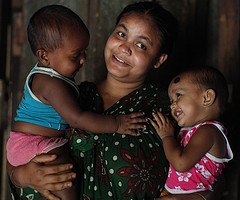It’s not every day you see your words and research findings on a flyer sent to members of Congress. That’s exactly what happened to IFPRI researcher John Hoddinott a few weeks ago. The flyer, prepared by the anti-hunger organization Bread for the World, was distributed in advance of a briefing on Capitol Hill to highlight a new US Agency for International Development nutrition strategy that focuses on the first critical 1,000 days of a child’s life, from the mother’s pregnancy to the child’s second birthday.
Last week Hoddinott found himself sitting in a high-ceilinged, wood-paneled room in the Rayburn Congressional Office Building. He was describing the impact of investments in preventing child undernutrition to policymakers from both sides of the aisle, USAID Administrator Rajiv Shah, and the leaders of some of the top organizations in the fight against global hunger and undernutrition.
We asked John Hoddinott about the impact of his research and his first Capitol Hill briefing experience.
IFPRI: Why did you decide to participate in this briefing? How did it all come about?
JH: Earlier this year, I was put in touch with Bread for the World, an NGO that’s part of a larger group working on nutrition, and I went to talk to them about the economic issues around investments to reduce undernutrition in early life. It all went very well. Then in August, they told me they were planning a Congressional briefing and asked if I’d like to participate. I said I was quite happy to go along if I could have a speaking part.
IFPRI: Well you definitely had speaking role! How did it go? Did anything surprise you?
JH: Not only do all these people live incredibly busy lives, there are times when they do not really have a lot of control over their own schedules. So I was curious about who would actually show up.
What was striking was not only that the USAID Administrator showed up, but that by the time they finished, four different people from the House of Representatives came in. And they all said, “We think this is really important legislation, we’re supportive of this idea, and we’ll see if we can push it through.” These were not only Democrats, who would naturally support this kind of thing, but also staunch conservatives.
That was a complete surprise.
IFPRI: How was your IFPRI research instrumental in this effort?
JH: The briefing drew, in part, on research I have been doing with IFPRI colleagues and others on the economics of investments to reduce undernutrition. Bread for the World sent around a flyer, which basically had a quote and a graphic from one of my papers. I gather this went to members of Congress because, at the briefing one member didn’t quote it verbatim, but he quoted the gist of it.
In terms of influencing policy–whether in the US or elsewhere–there is no substitute for good research. High quality research, done credibly, is the starting point for us. Once you have that, being able to describe it in ways that are widely accessible is useful. The trick is that you need both things together.
IFPRI: One last question: Did the Congressional halls of power look like a scene from House of Cards?
JH: Well, we weren’t in the grandest room in the building–that’s the room where the committee on appropriations meets. We were up a couple floors from it. But it was a medium-grand room. And there was an element of House of Cards—I overheard someone say they would work on convincing a member of Congress by talking to his wife.
And even though the briefing was on the third floor, I took the elevator on the way up—it was wood paneled. So it was fun that way.
Related paper: The economic rationale for investing in stunting reduction







